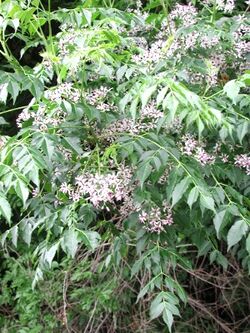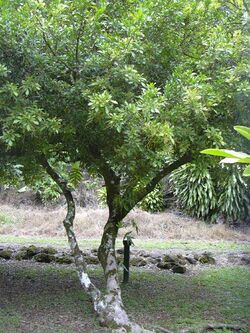Biology:Meliaceae
| Meliaceae | |
|---|---|

| |
| Melia azedarach in flower | |
| Scientific classification | |
| Kingdom: | Plantae |
| Clade: | Tracheophytes |
| Clade: | Angiosperms |
| Clade: | Eudicots |
| Clade: | Rosids |
| Order: | Sapindales |
| Family: | Meliaceae Juss.[1] |
| Subfamilies | |
| |
Meliaceae, the mahogany family, is a flowering plant family of mostly trees and shrubs (and a few herbaceous plants, mangroves) in the order Sapindales.
They are characterised by alternate, usually pinnate leaves without stipules, and by syncarpous,[2] apparently bisexual (but actually mostly cryptically unisexual) flowers borne in panicles, cymes, spikes or clusters. Most species are evergreen, but some are deciduous, either in the dry season or in winter.
The family includes about 53 genera and about 600 known species,[3] with a pantropical distribution; one genus (Toona) extends north into temperate China and south into southeast Australia, another (Synoum) into southeast Australia, and another (Melia) nearly as far north. They most commonly grow as understory trees in rainforests, but are also found in mangroves and arid regions.[4]
The fossil record of the family extends back into the Late Cretaceous.[5]

Uses
Various species are used for vegetable oil, soap-making, insecticides, and highly prized wood (mahogany).
Some economically important genera and species belong to this family:
- Azadirachta indica, neem tree (India)
- Carapa: includes the "crabwood trees" e.g. Carapa procera (South America and Africa)
- Cedrela odorata Central and South America; timber also known as Spanish-cedar
- Entandrophragma: includes sapele (Entandrophragma cylindricum), and "utile" or "sipo" (E. utile) of tropical Africa
- Guarea, the genus of Bossé or "pink mahogany", includes: G. thompsonii and G. cedrata (Africa)
- Khaya includes: Ivory Coast Mahogany and Senegal Mahogany (tropical Africa)
- Lansium parasiticum, lanzones, grown for its edible fruit in Southeast Asia
- Melia azedarach, Chinaberry or white cedar (Indomalaya and Australasia)
- Sandoricum koetjape, santol, grown for its edible fruit in Southeast Asia and South Asia
- Swietenia is the classic "mahogany" genus from the tropical Americas
- Toona: the genus of "toon tree" species (tropical Asia, Malesia, and Australia ), especially Toona ciliata
Genera

Subfamily Cedreloideae
This is also known as subfamily Swietenioideae.[6][7]
Subfamily Melioideae
Notes
- ↑ Angiosperm Phylogeny Group (2009). "An update of the Angiosperm Phylogeny Group classification for the orders and families of flowering plants: APG III". Botanical Journal of the Linnean Society 161 (2): 105–121. doi:10.1111/j.1095-8339.2009.00996.x.
- ↑ Of a gynoecium, made up of united carpels
- ↑ Christenhusz, M. J. M.; Byng, J. W. (2016). "The number of known plants species in the world and its annual increase". Phytotaxa 261 (3): 201–217. doi:10.11646/phytotaxa.261.3.1. http://biotaxa.org/Phytotaxa/article/download/phytotaxa.261.3.1/20598.
- ↑ Heywood, V.H.; Brummitt, R.K.; Culham, A.; Seberg, O. (2007). Flowering Plant Families of the World. Ontario, Canada: Firefly Books. pp. 207. ISBN 9781842461655.
- ↑ Atkinson, Brian A. (January 2020). "Fossil evidence for a Cretaceous rise of the mahogany family" (in en). American Journal of Botany 107 (1): 139–147. doi:10.1002/ajb2.1416. ISSN 0002-9122. PMID 31903551.
- ↑ 6.0 6.1 "Floral Development in the Tribe Cedreleae (Meliaceae, Sub-family Swietenioideae): Cedrela and Toona.". Annals of Botany 101 (1): 39–48. 2008. doi:10.1093/aob/mcm279. PMID 17981877.
- ↑ "Missouri Botanic Garden: list of Meliaceae genera (retrieved 18 January 2018)". https://www.mobot.org/MOBOT/research/APWeb/genera/meliaceaegen.html.
- ↑ "Koenen E (2011) Phylogenetic and biogeographic studies in Guareeae (Meliaceae: Melioideae) - (retrieved 18 January 2018)". http://edepot.wur.nl/189376.
- ↑ Koenen E (2011) ibid.
References
- Pennington, T.D. & Styles, B.T. (1975): A generic monograph of the Meliaceae. Blumea 22: 419–540.
External links
- Meliaceae in L. Watson and M.J. Dallwitz (1992 onwards). The families of flowering plants.
- Project Meliaceae
Wikidata ☰ Q158979 entry
 |
